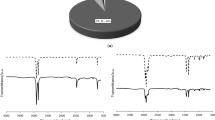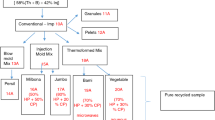Abstract
Seven waste thermoplastic polymers (polypropylene, polyethylene film, polyethylene terephthalate, polystyrene, acrylonitrile–butadiene–styrene, high-impact polystyrene and polybutadiene terephthalate, denoted as PP, PE (film), PET, PS, ABS, HIPS and PBT, respectively) and four synthetic mixtures thereof with different compositions representing commingled postconsumer plastic waste and waste of electrical and electronic equipment were studied by means of simultaneous thermogravimetry/differential scanning calorimetry coupled with Fourier transform infrared spectroscopy (TG/DSC–FTIR) under pyrolytic conditions (inert atmosphere). By summing all the heat change contributions due to physical and/or chemical processes occurring (i.e., melting, decomposition), an overall energy, defined as the degradation heat, was determined for both single component and their mixtures. It was found to be about 4–5 % of the exploitable energy of the input material. Vapors evolved during the pyrolysis of single-component polymers and their mixtures, analyzed using the FTIR apparatus, allowed identifying the main reaction products as monomers or fragments of the polymeric chain. Results from TG/DSC runs and FTIR analysis show that there is no interaction among the plastic components of the mixtures during the occurrence of pyrolysis.



Similar content being viewed by others
References
Adrados A, De Marco I, Caballero BM, Lopez A. Pyrolysis of plastic packaging waste: a comparison of plastic residuals from material recovery facilities with simulated plastic waste. Waste Manag. 2012;32:826–32.
Cui J, Forssberg E. Mechanical recycling of waste electric and electronic equipment: a review. J Hazard Mater. 2003;99(3):243–63.
Directive 2012/19/EU of the European Parliament and of the Council of 4 July 2012 on waste electric and electronic equipment (WEEE).
Brandrup J. Recycling and recovery of plastics. Munich: Hanser publishers; 1996.
Directive 2004/12/EC of the European Parliament and of the Council of 11 February 2004 amending Directive 94/62/EC on packaging and packaging waste.
Plastics Europe. An analysis of European latest plastics production, demand and waste data. 2013. In: Plastics—the facts 2013. http://www.plasticseurope.org/Document/plastics-the-facts-2013.aspx. Accessed 25 Nov 2014.
Dimitrakakis E, Janz A, Bilitewski B, Gidarakos E. Small WEEE: determining recyclables and hazardous substances in plastics. J Hazard Mater. 2009;161:913–9.
Schlummer M, Gruber L, Maurer A, Wolz G, Van Eldik R. Characterisation of polymer fractions from waste electrical and electronic equipment (WEEE) and implications for waste management. Chemosphere. 2007;67:1866–76.
Directive 2011/65/EU of the European Parliament and of Council of 8 June 2011 on the restriction of the use of certain hazardous substances in electrical and electronic equipment (RoHS Directive).
Blanco I, Abate L, Bottino FA. Variously substituted phenyl hepta cyclopentyl-polyhedral oligomeric silsesquioxane (ph, hcp-POSS)/polystyrene (PS) nano-composites. The influence of substituents on the thermal stability. J Therm Anal Calorim. 2013;112:421–8.
Blanco I, Bottino FA, Bottino P. Influence of symmetry/asymmetry of the nanoparticles structure on the thermal stability of polyhedral oligomeric silsesquioxane/polystyrene nanocomposites. Polym Compos. 2012;33(11):1903–10.
Westerhout RWJ, Waanders J, Kuipers JAM, van Swaaij WPM. Kinetics of the low-temperature pyrolysis of polyethene, polypropene, and polystyrene modeling, experimental determination, and comparison with literature models and data. Ind Eng Chem Res. 1997;36:1955–64.
Encinar JM, Gonzales JF. Pyrolysis of synthetic polymers and plastic wastes. Kinetic study. Fuel Process Technol. 2008;89(7):678–86.
Liu H, Kong Q, Cheng Y, Cao G. Thermal decomposition kinetics of high impact polystyrene/organo Fe-montmorillonite nanocomposites. Chin J Chem. 2012;30:1594–600.
Yang M. The thermal degradation of acrylonitrile–butadiene–styrene terpolymer under various gas conditions. Polym Test. 2000;19:105–10.
Materazzi S, Vecchio S, De Angelis Curtis S. Thermal analysis and health safety: thermoanalytical characterization of hardwood and softwood dust. J Therm Anal Calorim. 2013;112:529–33.
Materazzi S, Vecchio S. Evolved gas analysis by infrared spectroscopy. Appl Spectr Rev. 2010;45(4):241–73.
Lopez-Urionabarrenechea A, de Marco I, Caballero BM, Adrados A, Laresgoiti MF. Empiric model for the prediction of packaging waste pyrolysis yields. Appl Energy. 2012;98:524–32.
Cafiero L, Castoldi E, Tuffi R, Vecchio Ciprioti S. Identification of some mixed plastics from small appliances and kinetic analysis of their thermally activated pyrolysis. Polym Degrad Stab. 2014;109:307–18.
ASTM D7582-12 Standard Test Methods for Proximate Analysis of Coal and Coke by Macro Thermogravimetric Analysis, 2012.
Holland BJ, Hay JN. The thermal degradation of PET and analogous polyesters measured by thermal analysis—Fourier transform infrared spectroscopy. Polymer. 2002;43:1835–47.
Stoliarov SI, Walters RN. Determination of the heats of gasification of polymers using differential scanning calorimetry. Polym Degrad Stab. 2008;93:422–7.
Frederick WJ, Mentzer CC. Determination of heats of volatilization for polymers by differential scanning calorimetry. J Appl Polym Sci. 1975;19:1799–804.
Wen J, Mark JE. Physical properties of polymers handbook. New York: AIP; 1996.
Williams PT, Williams E. Interaction of plastics in mixed-plastics pyrolysis. Energy Fuel. 1999;13:188–96.
Samperi F, Puglisi C, Alicata R, Montaudo G. Thermal degradation of poly(butyleneterephthalate) at the processing temperature. Polym Degrad Stabil. 2004;83:11–7.
Buyle A, Padias H, Hall K. Oligomeric bishydroxybutyl terephthalates from terephthalic acid. J Polym Sci. 1981;19:1021–32.
Author information
Authors and Affiliations
Corresponding authors
Rights and permissions
About this article
Cite this article
Cafiero, L., Fabbri, D., Trinca, E. et al. Thermal and spectroscopic (TG/DSC–FTIR) characterization of mixed plastics for materials and energy recovery under pyrolytic conditions. J Therm Anal Calorim 121, 1111–1119 (2015). https://doi.org/10.1007/s10973-015-4799-2
Received:
Accepted:
Published:
Issue Date:
DOI: https://doi.org/10.1007/s10973-015-4799-2




